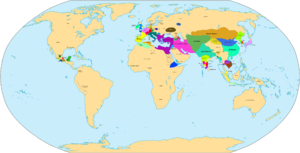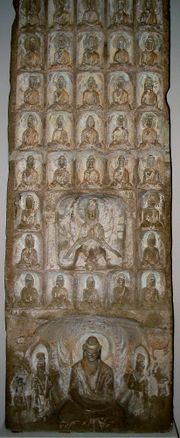| Millennium: |
1st millennium |
| Centuries: |
5th century · 6th century · 7th century |
| Decades: |
500s 510s 520s 530s 540s
550s 560s 570s 580s 590s |
| Categories: |
Births – Deaths
Establishments – Disestablishments |

The world at the beginning of the 6th century AD.

Eastern Hemisphere at the end of the 6th century AD.
The 6th century is the period from 501 to 600 in accordance with the Julian calendar in the Christian Era. This century is widely considered to mark the end of Classical Antiquity and the beginning of the Dark Ages.
Overview
Following the collapse of the Western Roman Empire late in the previous century, Europe fractured into many small Germanic Kingdoms, which competed fiercely for land and wealth. From this upheaval the Franks rose to prominence, and carved out a sizeable domain encompassing much of modern France and Germany. Meanwhile, the surviving Eastern Roman Empire began to expand under the emperor Justinian, who eventually recaptured North Africa from the Vandals, and attempted to fully recover Italy as well in the hope of re-establishing Roman control over the lands once ruled by the Western Roman Empire. Following Justinian's death, most of his gains were lost. The Sassanid Empire reached the peak of its power under Khosrau I in the 6th century.
Events

This
Buddhist stela from
China, Northern Wei period, was built in the early 6th century.
- The first academy of the east the Academy of Gundeshapur founded in Iran by Khosrau I of Persia.
- Irish colonists and invaders, the Scots, began migrating to Caledonia (later known as Scotland). Migration from south-west Britain to Brittany.
- Glendalough monastery, Wicklow Ireland founded by St. Kevin. Many similar foundations in Ireland and Wales.
- The monastery on Iona is founded by St. Columban
- Zen Buddhists enter Vietnam from China.
- Buddhist Jataka stories are translated into Persian by order of the Zoroastrian king Khosrau.
- 518 - Roman Emperor Anastasius I dies and is succeeded by Justin I.
- 527 — Justinian I succeeds Justin I as Emperor of the Eastern Roman Empire.
- 529 — Saint Benedict of Nursia founds the monastery of Monte Cassino in Italy.
- 532 — Nika riots in Constantinople; the cathedral is destroyed. They are put down a sennight later by Belisarius and Mundus; up to 30,000 people are killed in the Hippodrome.
- 535 - Possible volcanic eruption causes several years of abnormally cold weather, resulting in mass famine.
- 537: Battle of Camlann, final battle of King Arthur
- c. 538- 540 - First Pandemic of bubonic plague hits Byzantine Empire.
- Buddhism introduced to Japan from Baekje in 552, thus contributing to the changes that occurred in the Asuka period.
- 554, Eviction of the Ostrogoths from Rome, and the re-unification of all Italy under Imperial rule.
- Outbreak of bubonic plague in Constantinople and the rest of the Byzantine Empire ( Plague of Justinian).
- The Kutrigur Bulgars move into modern Romania.
- Jewish influence in Aksum.
- Nubia is largely converted to Coptic Christianity.
- The area of modern Aargau falls into the Franks.
- The Kingdom of Funan dies out.
- Black Death raged over south east Asia.
- Silk Road farther into Europe.
- 589–618: Sui Dynasty of China
- Old Irish language develops
- Old Dutch language develops
- Abraha attacks Kaaba in Mecca (circa 571)
- 590, Pope Gregory I succeeds Pope Pelagius II as the 64th pope.
Significant persons
- Muhammad, prophet of Islam, born in 570.
- Pope Gregory the Great (590–604)
- Arthur, (fictional?) defeated the Anglo-Saxons
- Justinian, Byzantine Emperor (527–565)
- Khosrau I of Persia, Sassanid king (531–579)
- Belisarius, Byzantine general.
- Gregory of Tours (c. 538–594)
- Beowulf, (fictional?) king of the Geats
- Jordanes, author of the Getica.
- Procopius, Byzantine historian.
- Bozorgmehr, Persian sage.
- Empress Suiko of Japan
- Taliesin, Welsh poet
- Abraham Kidunaia
- Austell
- Yasodharman, king of Malwa in India, defeats the Huns.
Inventions, discoveries, introductions
- Dionysius Exiguus creates the Anno Domini system, inspired by the birth of Jesus, in 525. This is the system upon which the Gregorian calendar and Common Era systems are based.
- Backgammon (nard) invented in Persia by Burzoe
- Chess, as chaturanga, entered Persia from India and was modified to shatranj.
- Breast-strap horse harness in use in Frankish kingdom
- Byzantine Empire acquires silk technology from China
- Vaghbata, Indian medical books
- In 589 AD, the Chinese scholar-official Yan Zhitui makes the first reference to the use of toilet paper in history.
- Significant to the history of agriculture, the Chinese author Jia Sixia wrote the treatise Chi Min Yao Shu in 535, and although it quotes 160 previous Chinese agronomy books, it is the oldest existent Chinese agriculture treatise. In over one hundred thousand written Chinese characters, the book covered land preparation, seeding, cultivation, orchard management, forestry, animal husbandry, trade, and culinary uses for crops.
Decades and years
|
Decades and years |
|
|
6th century4th century←5th century← ↔ →7th century→8th century
| 490s |
490 |
491 |
492 |
493 |
494 |
495 |
496 |
497 |
498 |
499 |
| 500s |
500 |
501 |
502 |
503 |
504 |
505 |
506 |
507 |
508 |
509 |
| 510s |
510 |
511 |
512 |
513 |
514 |
515 |
516 |
517 |
518 |
519 |
| 520s |
520 |
521 |
522 |
523 |
524 |
525 |
526 |
527 |
528 |
529 |
| 530s |
530 |
531 |
532 |
533 |
534 |
535 |
536 |
537 |
538 |
539 |
| 540s |
540 |
541 |
542 |
543 |
544 |
545 |
546 |
547 |
548 |
549 |
| 550s |
550 |
551 |
552 |
553 |
554 |
555 |
556 |
557 |
558 |
559 |
| 560s |
560 |
561 |
562 |
563 |
564 |
565 |
566 |
567 |
568 |
569 |
| 570s |
570 |
571 |
572 |
573 |
574 |
575 |
576 |
577 |
578 |
579 |
| 580s |
580 |
581 |
582 |
583 |
584 |
585 |
586 |
587 |
588 |
589 |
| 590s |
590 |
591 |
592 |
593 |
594 |
595 |
596 |
597 |
598 |
599 |
| 600s |
600 |
601 |
602 |
603 |
604 |
605 |
606 |
607 |
608 |
609 |
|
|
|
Centuries and millennia |
|
|
| Millennium |
Century |
| BC |
| 4th |
40th |
39th |
38th |
37th |
36th |
35th |
34th |
33rd |
32nd |
31st |
| 3rd |
30th |
29th |
28th |
27th |
26th |
25th |
24th |
23rd |
22nd |
21st |
| 2nd |
20th |
19th |
18th |
17th |
16th |
15th |
14th |
13th |
12th |
11th |
| 1st |
10th |
9th |
8th |
7th |
6th |
5th |
4th |
3rd |
2nd |
1st |
| AD |
| 1st |
1st |
2nd |
3rd |
4th |
5th |
6th |
7th |
8th |
9th |
10th |
| 2nd |
11th |
12th |
13th |
14th |
15th |
16th |
17th |
18th |
19th |
20th |
| 3rd |
21st |
22nd |
23rd |
24th |
25th |
26th |
27th |
28th |
29th |
30th |
| 4th |
31st |
|
|


